Science & Environment
Why did the UK’s first satellite end up thousands of miles from where it should have been?
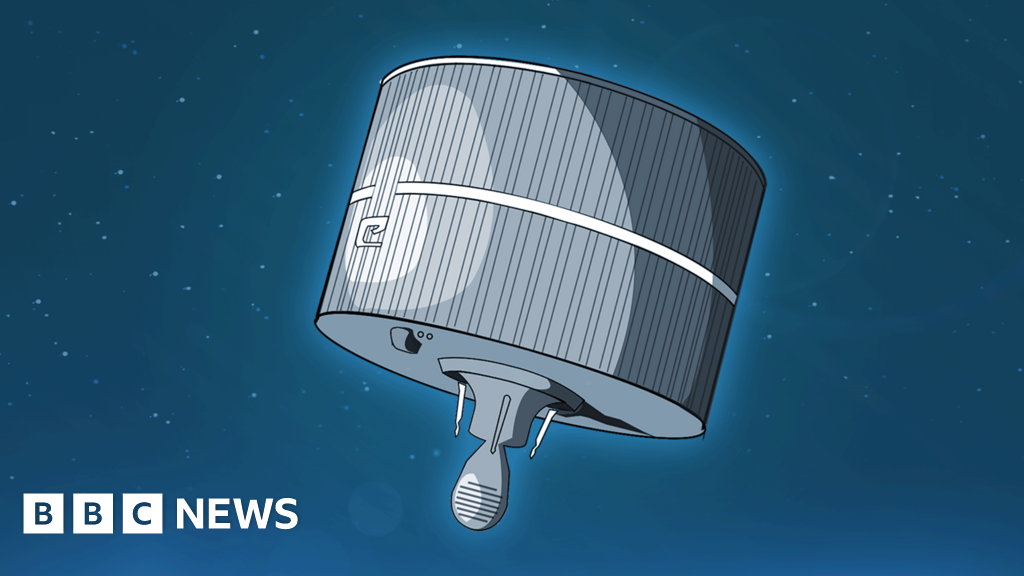
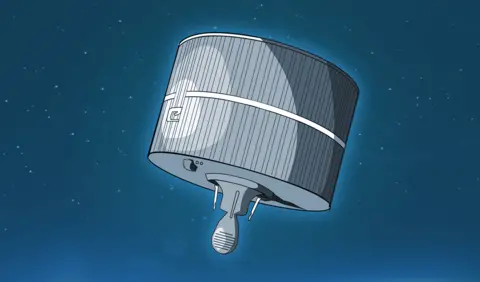 BBC/Gerry Fletcher
BBC/Gerry FletcherSomeone moved the UK’s oldest satellite and there appears to be no record of exactly who, when or why.
Launched in 1969, just a few months after humans first set foot on the Moon, Skynet-1A was put high above Africa’s east coast to relay communications for British forces.
When the spacecraft ceased working a few years later, gravity might have been expected to pull it even further to the east, out over the Indian Ocean.
But today, curiously, Skynet-1A is actually half a planet away, in a position 22,369 miles (36,000km) above the Americas.
Orbital mechanics mean it’s unlikely the half-tonne military spacecraft simply drifted to its current location.
Almost certainly, it was commanded to fire its thrusters in the mid-1970s to take it westwards. The question is who that was and with what authority and purpose?
It’s intriguing that key information about a once vital national security asset can just evaporate. But, fascination aside, you might also reasonably ask why it still matters. After all, we’re talking about some discarded space junk from 50 years ago.
“It’s still relevant because whoever did move Skynet-1A did us few favours,” says space consultant Dr Stuart Eves.
“It’s now in what we call a ‘gravity well’ at 105 degrees West longitude, wandering backwards and forwards like a marble at the bottom of a bowl. And unfortunately this brings it close to other satellite traffic on a regular basis.
“Because it’s dead, the risk is it might bump into something, and because it’s ‘our’ satellite we’re still responsible for it,” he explains.
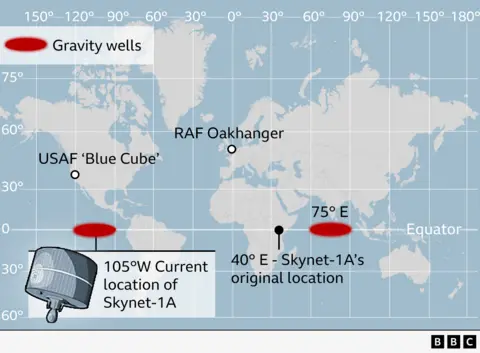 BBC/Gerry Fletcher
BBC/Gerry FletcherDr Eves has looked through old satellite catalogues, the National Archives and spoken to satellite experts worldwide, but he can find no clues to the end-of-life behaviour of Britain’s oldest spacecraft.
It might be tempting to reach for a conspiracy theory or two, not least because it’s hard to hear the name “Skynet” without thinking of the malevolent, self-aware artificial intelligence (AI) system in The Terminator movie franchise.
But there’s no connection other than the name and, in any case, real life is always more prosaic.
What we do know is that Skynet-1A was manufactured in the US by the now defunct Philco Ford aerospace company and put in space by a US Air Force Delta rocket.
“The first Skynet satellite revolutionised UK telecommunications capacity, permitting London to securely communicate with British forces as far away as Singapore. However, from a technological standpoint, Skynet-1A was more American than British since the United States both built and launched it,” remarked Dr Aaron Bateman in a recent paper on the history of the Skynet programme, which is now on its fifth generation.
This view is confirmed by Graham Davison who flew Skynet-1A in the early 70s from its UK operations centre at RAF Oakhanger in Hampshire.
“The Americans originally controlled the satellite in orbit. They tested all of our software against theirs, before then eventually handing over control to the RAF,” the long-retired engineer told me.
“In essence, there was dual control, but when or why Skynet-1A might have been handed back to the Americans, which seems likely – I’m afraid I can’t remember,” says Mr Davison, who is now in his 80s.
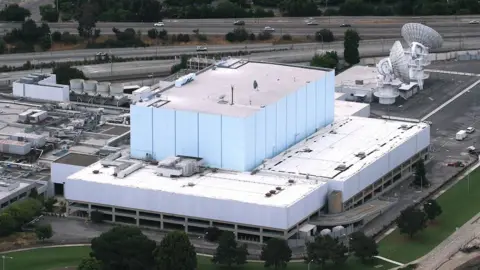 Sunnyvale Heritage Park Museum
Sunnyvale Heritage Park MuseumRachel Hill, a PhD student from University College London, has also been scouring the National Archives.
Her readings have led her to one very reasonable possibility.
“A Skynet team from Oakhanger would go to the USAF satellite facility in Sunnyvale (colloquially known as the Blue Cube) and operate Skynet during ‘Oakout’. This was when control was temporarily transferred to the US while Oakhanger was down for essential maintenance. Perhaps the move could have happened then?” Ms Hill speculated.
The official, though incomplete, logs of Skynet-1A’s status suggest final commanding was left in the hands of the Americans when Oakhanger lost sight of the satellite in June 1977.
But however Skynet-1A then got shifted to its present position, it was ultimately allowed to die in an awkward place when really it should have been put in an “orbital graveyard”.
This refers to a region even higher in the sky where old space junk runs zero risk of running into active telecommunications satellites.
Graveyarding is now standard practice, but back in the 1970s no-one gave much thought to space sustainability.
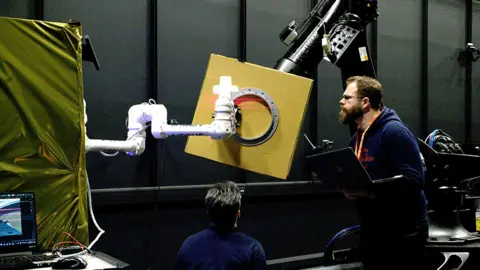 Astroscale
AstroscaleAttitudes have since changed because the space domain is getting congested.
At 105 degrees West longitude, an active satellite might see a piece of junk come within 50km of its position up to four times a day.
That might sound like they’re nowhere near each other, but at the velocities these defunct objects move it’s starting to get a little too close for comfort.
The Ministry of Defence said Skynet-1A was constantly monitored by the UK’s National Space Operations Centre. Other satellite operators are informed if there’s likely to be a particularly close conjunction, in case they need to take evasive action.
 Northrop Grumman
Northrop GrummanUltimately, though, the British government may have to think about removing the old satellite to a safer location.
Technologies are being developed to grab junk left in space.
Already, the UK Space Agency is funding efforts to do this at lower altitudes, and the Americans and the Chinese have shown it’s possible to snare ageing hardware even in the kind of high orbit occupied by Skynet-1A.
“Pieces of space junk are like ticking time bombs,” observed Moriba Jah, a professor of aerospace engineering at the University of Texas at Austin.
“We need to avoid what I call super-spreader events. When these things explode or something collides with them, it generates thousands of pieces of debris that then become a hazard to something else that we care about.”
Science & Environment
Study finds great white sharks less likely to attack surfboards with bright lights: “Like an invisibility cloak”
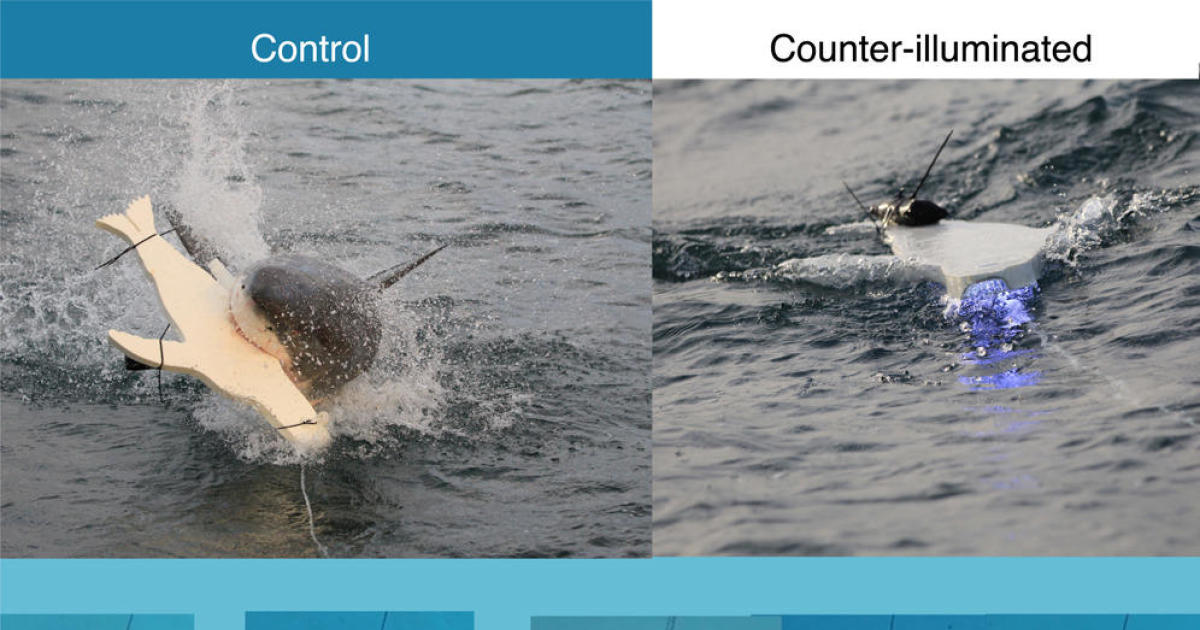
Covering your surfboard in bright lights sounds like an open invitation to great white sharks, but research released Tuesday by Australian scientists found it might actually stave off attacks.
Biologist Laura Ryan said the predator often attacked its prey from underneath, occasionally mistaking a surfer’s silhouette for the outline of a seal.
Ryan and her fellow researchers showed that seal-shaped boards decked with bright horizontal lights were less likely to be attacked by great white sharks.
This appeared to be because the lights distorted the silhouette on the ocean’s surface, making it appear less appetizing.
“There is this longstanding fear of white sharks and part of that fear is that we don’t understand them that well,” said Ryan, from Australia’s Macquarie University.
The study, published in the journal Current Biology, was conducted in the waters of South Africa’s Mossel Bay, a popular great white feeding ground.
Seal-shaped decoys were strung with different configurations of LED lights and towed behind a boat to see which attracted the most attention.
Brighter lights were better at deterring sharks, the research found, while vertical lights were less effective than horizontal.
Macquarie University Professor Nathan Hart, one of the study’s authors, said the lights caused a “complex interaction” with the shark’s behavior.
“It’s like an invisibility cloak but with the exception that we are splitting the object, the visual silhouette, into smaller bits,” Hart said.
The study’s authors released a video showing some of the research in action.
Ryan said the results were better than expected and is now in the process of building prototypes for use on the underside of kayaks and surfboards.
Australia has some of the world’s most comprehensive shark management measures, including monitoring drones, shark nets and a tagging system that alerts authorities when a shark is near a crowded beach.
Ryan said her research could allow less invasive mitigation methods to be used.
More research was needed to see if bull and tiger sharks — which have different predatory behavior — responded to the lights in a similar way, the authors said.
There have been more than 1,200 shark incidents in Australia since 1791, of which 255 resulted in death, official data shows.
Great white sharks were responsible for 94 of those deaths.
The overall number of deadly shark attacks worldwide in 2023 remained relatively low, but it was still twice the previous year’s total, according to the latest iteration of the International Shark Attack File — a database of global shark attacks run by the University of Florida.
The report noted that a “disproportionate” amount of people died from shark bites in Australia last year compared with other countries around the world.
Science & Environment
Jets of liquid bounce off hot surfaces without ever touching them


If you cook with stainless steel pans, you’re probably familiar with the Leidenfrost effect
Franck Celestini
A jet of liquid can bounce off of a hot plate without ever touching it. This extension of the Leidenfrost effect – the phenomenon that allows beads of water to skitter across a scorching pan – could help improve cooling processes, from nuclear reactors to firefighting.
Though first described nearly 300 years ago, the Leidenfrost effect has only been tested with fluid droplets, not squirts of liquid. Until now.
Frack Celestini at Côte d’Azur…
Science & Environment
Exxon CEO says Trump should keep U.S. involved in global effort to address climate change

Darren Woods, chairman and chief executive officer of Exxon Mobil Corp., speaks during the 2022 CERAWeek by S&P Global conference in Houston, Texas, on Monday, March 7, 2022.
F. Carter Smith | Bloomberg | Getty Images
President-elect Donald Trump should keep the U.S. involved in global efforts to address climate change, Exxon Mobil CEO Darren Woods said Tuesday.
Trump should try to bring a “common sense” approach to the annual U.N. Climate Change Conference and “continue to have the U.S. influence policy around the world,” Woods told CNBC’s “Squawk Box” Tuesday. Woods spoke from the climate conference, which kicked off this week in Baku, Azerbaijan.
Trump withdrew the U.S. from the Paris climate agreement in 2017 and is expected to do so again in his second term. President Joe Biden signed an order to rejoin the agreement on his first day in office in 2021, a decision that Exxon supported.
Trump slammed the Paris agreement as “horribly unfair to the U.S.” and vowed to rescind all unspent funds under the Inflation Reduction Act in an address to the Economic Club of New York in September. He made energy policy a central part of his campaign platform, calling for unconstrained fossil fuel production.
Exxon has plans to invest $20 billion through 2027 in carbon capture and storage technology, hydrogen fuel, and lithium mining in the U.S. for electric vehicle batteries.
Woods told CNBC on Tuesday that Exxon’s investments in technologies to lower emissions depend on federal tax credits that were established or expanded under the IRA. He warned that the company’s investments in these technologies would change if the incentives are weakened or repealed.
“There needs to be an incentive to reward those investments and generate a return,” Woods said. “If we find that those incentives dissipate or go away entirely, then that would definitely change our investment plans.”
Wood previously said Exxon’s oil and gas production levels will not change, at least in the short term, in response to the outcome of the U.S. presidential election.
“I’m not sure how ‘drill, baby, drill’ translates into policy,” Woods told CNBC’s “Squawk Box” on Nov. 1, referencing one of Trump’s campaign slogans.
The CEO said Exxon has not faced constraints on its shale production under the Biden administration. Exxon’s production levels are based on how much money the company can return to shareholders, not which political party is on office, he said.
Exxon shares have risen more than 20% since the start of the year,
Science & Environment
EPA to hit oil and gas companies with “methane fee” for drilling waste — but will it last?
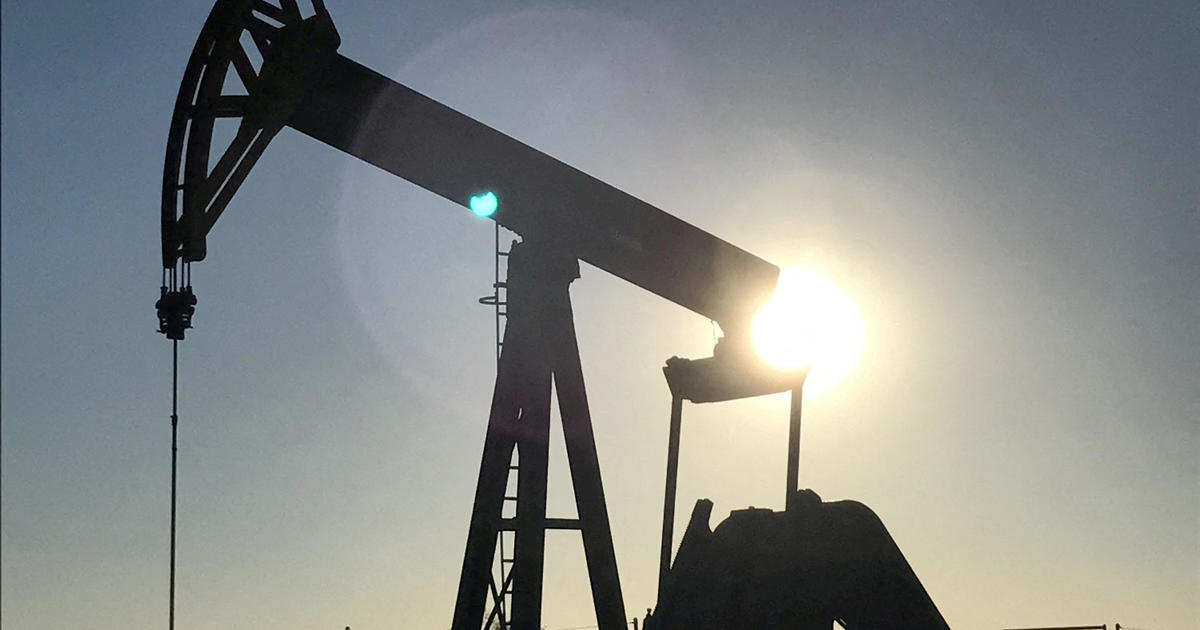
Washington — Oil and natural gas companies for the first time will have to pay a federal fee if they emit dangerous methane above certain levels under a rule being made final by the Biden administration.
The Environmental Protection Agency rule follows through on a directive from Congress included in the 2022 climate law. The new fee is intended to encourage industry to adopt best practices that reduce emissions of methane – the primary component of natural gas – and thereby avoid paying.
Methane is a climate “super pollutant” that is far more potent in the short term than carbon dioxide and is responsible for about one-third of greenhouse gas emissions. The oil and natural gas sector is the largest industrial source of methane emissions in the United States, and advocates say reduction of methane emissions is a crucial way to slow climate change.
The rule, set to be announced Tuesday at an international climate conference in Azerbaijan, comes hours after President-elect Donald Trump named former New York congressman Lee Zeldin to head the agency in Trump’s second term. If confirmed by the Senate, Zeldin is expected to move to reverse or loosen dozens of environmental regulations approved under President Biden as Trump seeks to establish U.S. “energy dominance″ worldwide.
Trump is likely to target the methane fee amid a flurry of expected actions he has promised to deregulate the oil and gas industry.
As outlined by the EPA, excess methane produced in 2024 could result in a fee of $900 per ton, with fees rising to $1,200 per ton in 2025 and $1,500 per ton by 2026. Industry groups are likely to challenge the rule, including any effort to impose a retroactive fee.
The rule wouldn’t become final until early next year, following publication in the Federal Register.
EPA Administrator Michael Regan said in a statement that the rule will work in tandem with a new EPA rule on methane emissions imposed this year. The rule targets the U.S. oil and natural gas industry for its role in global warming as Mr. Biden seeks to secure his legacy on fighting climate change.
The fee, formally known as the Waste Emissions Charge, will encourage early deployment of available technologies to reduce methane emissions and other harmful air pollutants, Regan said. The fee “is the latest in a series of actions under President Biden’s methane strategy to improve efficiency in the oil and gas sector, support American jobs, protect clean air and reinforce U.S. leadership on the global stage,” he said.
Industry groups and Republican-led states have challenged the earlier methane rule in court, but lost a bid for the Supreme Court to block the rule while the case continues before lower-level judges.
Opponents argue that the EPA overstepped its authority and set unattainable standards with the new regulations. The EPA, though, said the rules are squarely within its legal responsibilities and would protect the public.
Many large oil and gas companies already meet or exceed methane-performance levels set by Congress under the climate law, meaning they are unlikely to be forced to pay the new fee, Regan and other officials said.
Even so, the EPA estimates that the rule will result in cumulative emissions reductions of 1.2 million metric tons of methane (the equivalent of 34 million metric tons of carbon-dioxide) through 2035. That figure is similar to clean-air gains from taking nearly 8 million gas-powered cars off the road for a year, the EPA said. Cumulative climate benefits could total as much $2 billion, the agency said.
Like the earlier methane rule, the new fee faces a near-certain legal challenge from industry groups. The American Petroleum Institute, the oil and gas industry’s largest lobbying group, called a fee proposed earlier this year a “punitive tax increase” that “undermines America’s energy advantage.”
The API said it looks forward to working with Congress to repeal the “misguided new tax on American energy.”
Environmental groups, for their part, have hailed the impending methane fee, saying oil and gas companies should be held accountable for pollution that contributes to global warming. Oil and gas companies routinely calculate that it’s cheaper to waste methane through flaring and other techniques than to make necessary upgrades to prevent leaks, they said.
The EPA said it expects that over time, fewer oil and gas companies will be charged for excess methane as they reduce emissions in compliance with the rule.
Science & Environment
Site of ancient, key battle in Iraq found by archeologists using spy satellite images
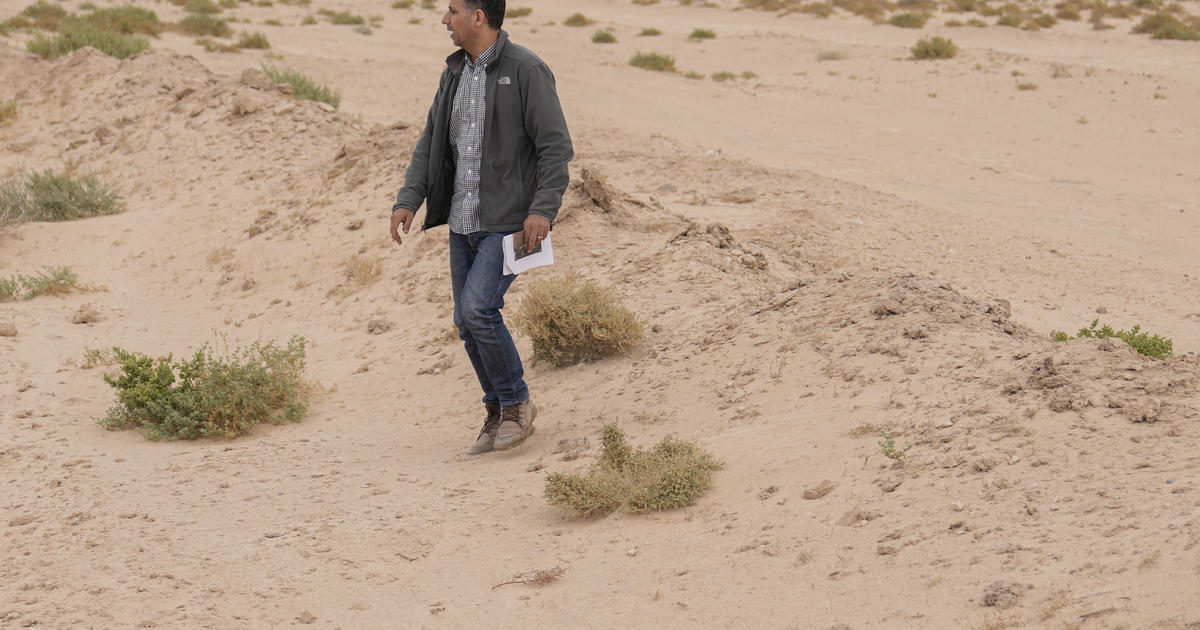
Beirut — Declassified 1970s-era U.S. spy satellite imagery has led a British-Iraqi archeological team to what they believe is the site of a seventh-century battle that became decisive in the spread of Islam throughout the region.
The Battle of al-Qadisiyah was fought in Mesopotamia — in present-day Iraq — in the A.D. 630s between Arab Muslims and the army of the Sassanid Persian dynasty during a period of Muslim expansion. The Arab army prevailed and continued on its march into Persia, now Iran.
A joint team of archeologists from the U.K.’s Durham University and the University of Al-Qadisiyah stumbled across the site while undertaking a remote sensing survey to map the Darb Zubaydah, a pilgrimage route from Iraq’s Kufa to Mecca in Saudi Arabia built more than 1,000 years ago. The findings were published Tuesday in the journal Antiquity.
While mapping the route, the team noticed that a site some 20 miles south of Kufa in Iraq’s southern Najaf province — a desert area with scattered plots of agricultural land — had features that closely matched the description of the al-Qadisiyah battle site described in historic texts.
William Deadman, a specialist in archaeological remote sensing at Durham University, said the Cold War era satellite images are commonly used tools by archeologists working in the Middle East because the older images often show features that have been destroyed or altered and wouldn’t show up on present-day satellite images.
“The Middle East has developed so much in the last 50 years, both agricultural expansion and urban expansion,” he said. Some of the distinguishing features at the al-Qadisiyah site, such as a distinctive trench, were “much more pristine and clear” in the 1970s images, he said.
A survey on the ground confirmed the findings and convinced the team that they had correctly identified the site.
The key features were a deep trench, two fortresses and an ancient river that was reportedly once forded by elephant-mounted Persian troops, said Jaafar Jotheri, a professor of archeology at the University of Al-Qadisiyah who’s part of the team that made the discovery. The survey team also found pottery shards consistent with the time period when the battle took place.
A revealing, well-known battle
Jotheri said Iraqis of his generation, who grew up under the rule of Saddam Hussein, were all familiar with the battle in minute detail, down to the names of the generals on both sides.
The battle at the time had political connotations — Iraq was engaged in a devastating war with Iran through much of the 1980s. Saddam pointed to the Battle of Qadisiyah as a harbinger of victory for Iraq.
Like most children growing up in that era, Jotheri said he’d watched a popular movie about the battle multiple times as it was on regular rotation on television.
In the post-Saddam era, al-Qadisiyah has become something of a political litmus test. Iraqis’ views of the battle vary depending on their feelings toward Iran, which has expanded its influence in the country since the 2003 US-led invasion of Iraq that toppled Saddam.
“There is some political and religious context in this battle because now, of course, we have religious differences, ethnic differences, political differences in Iraq and we read or we view everything based on our … differences,” Jotheri said. But he added, “We all agree that it is a very important battle, a decisive one, and we all know about it.”
Discovery was part of a regional trend
The team plans to begin excavations at the site in the coming year, Jotheri said.
The discovery comes as part of a broader project launched in 2015 to document endangered archaeological sites in the region.
It also comes at the time of a resurgence of archeology in Iraq, a country often referred to as the “cradle of civilization,” but where archeological exploration has been stunted by decades of conflict that halted excavations and led to the looting of tens of thousands of artifacts.
In recent years, the digs have returned and thousands of stolen artifacts have been repatriated.
Science & Environment
Shell wins appeal against Dutch climate ruling to slash emissions
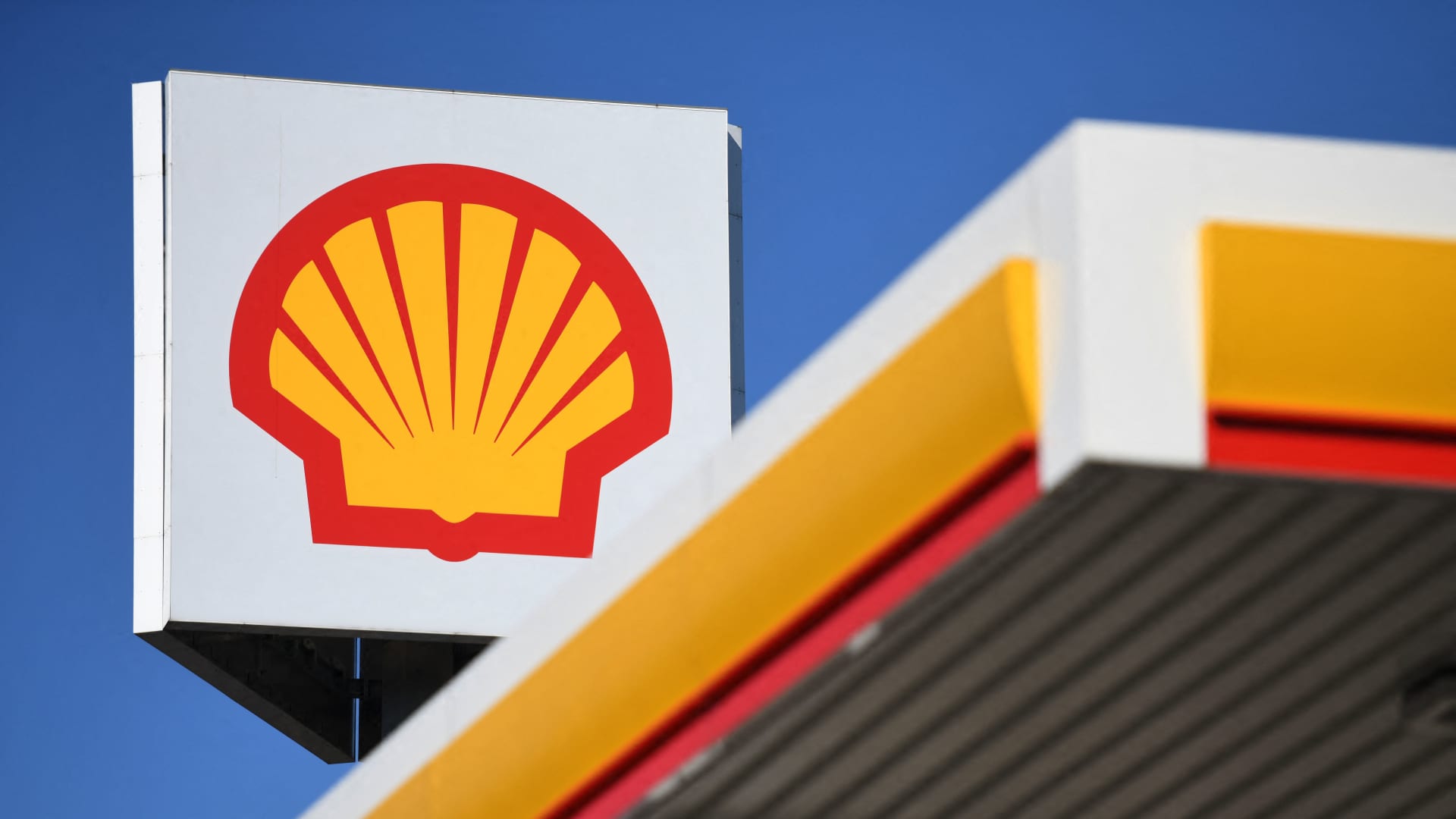
Oil storage silos beyond waterlogged land at the Shell Plc Pernis refinery in Rotterdam, Netherlands, on Sunday, Feb. 11, 2024.
Bloomberg | Bloomberg | Getty Images
A Dutch court on Tuesday ruled to dismiss a landmark climate ruling against Shell, after the oil giant was ordered to drastically reduce its global carbon emissions back in 2021.
The outcome, which comes during the opening days of the COP29 climate summit in Azerbaijan, marks the latest twist in a precedent-setting case that could have far-reaching implications for the future of climate litigation.
The appeals court in The Hague said that while Shell is required to reduce its carbon emissions, it could not determine the extent of these cuts. The case against Shell, therefore, was dismissed entirely.
In May 2021, The Hague district court ruled that Shell must reduce its greenhouse gas emissions by 45% from 2019 levels by 2030.
The verdict, which came when Shell had its headquarters in The Hague, also said the company was responsible for all emissions across its value chain, including those from the products they sell — known as Scope 3 emissions.
It was the first time in history that a company was found to have been legally obliged to align its policies with the Paris Agreement, a framework which seeks to avoid the worst of what the climate crisis has in store by limiting the average global temperature increase to between 1.5 and 2 degrees Celsius.
The ruling was regarded as a watershed moment in the climate battle and sparked a wave of lawsuits against other fossil fuel companies.
Shell appealed the 2021 decision and subsequently moved its headquarters to the U.K., a relocation that was criticized for being partly motivated by the courtroom defeat. The Hague district court ruling is only legally binding in the Netherlands.
In appeal hearings held earlier this year, the British oil major argued that the case had no legal basis.
Shell’s lawyers said demands for companies to curb greenhouse gas emissions could not be made by courts, but only by governments, Reuters reported. The company also said the court ruling would force it to shrink its business without any benefit to the fight against climate change.
The case was brought against Shell in 2019 by Milieudefensie, an environmental campaign group and the Dutch branch of Friends of the Earth, alongside six other bodies and more than 17,000 Dutch citizens.
The burning of coal, oil and gas is by far the largest contributor to the climate crisis, accounting for more than three-quarters of global greenhouse gas emissions.
This is breaking news. Please refresh for updates.
-

 Science & Environment2 months ago
Science & Environment2 months agoHow to unsnarl a tangle of threads, according to physics
-

 Technology2 months ago
Technology2 months agoWould-be reality TV contestants ‘not looking real’
-

 Technology2 months ago
Technology2 months agoIs sharing your smartphone PIN part of a healthy relationship?
-

 Science & Environment2 months ago
Science & Environment2 months agoHyperelastic gel is one of the stretchiest materials known to science
-

 Science & Environment2 months ago
Science & Environment2 months ago‘Running of the bulls’ festival crowds move like charged particles
-

 Science & Environment2 months ago
Science & Environment2 months agoX-rays reveal half-billion-year-old insect ancestor
-

 Science & Environment2 months ago
Science & Environment2 months agoPhysicists have worked out how to melt any material
-

 MMA1 month ago
MMA1 month ago‘Dirt decision’: Conor McGregor, pros react to Jose Aldo’s razor-thin loss at UFC 307
-

 News1 month ago
News1 month ago‘Blacks for Trump’ and Pennsylvania progressives play for undecided voters
-

 Sport1 month ago
Sport1 month agoAaron Ramsdale: Southampton goalkeeper left Arsenal for more game time
-

 News1 month ago
News1 month agoWoman who died of cancer ‘was misdiagnosed on phone call with GP’
-

 Money1 month ago
Money1 month agoWetherspoons issues update on closures – see the full list of five still at risk and 26 gone for good
-

 Football1 month ago
Football1 month agoRangers & Celtic ready for first SWPL derby showdown
-
Business1 month ago
how UniCredit built its Commerzbank stake
-

 Technology1 month ago
Technology1 month agoUkraine is using AI to manage the removal of Russian landmines
-

 Sport1 month ago
Sport1 month ago2024 ICC Women’s T20 World Cup: Pakistan beat Sri Lanka
-

 Science & Environment2 months ago
Science & Environment2 months agoMaxwell’s demon charges quantum batteries inside of a quantum computer
-

 Science & Environment2 months ago
Science & Environment2 months agoSunlight-trapping device can generate temperatures over 1000°C
-

 Science & Environment2 months ago
Science & Environment2 months agoA new kind of experiment at the Large Hadron Collider could unravel quantum reality
-

 Science & Environment2 months ago
Science & Environment2 months agoLiquid crystals could improve quantum communication devices
-

 Technology1 month ago
Technology1 month agoSamsung Passkeys will work with Samsung’s smart home devices
-

 Science & Environment2 months ago
Science & Environment2 months agoLaser helps turn an electron into a coil of mass and charge
-

 Science & Environment2 months ago
Science & Environment2 months agoQuantum forces used to automatically assemble tiny device
-
Business1 month ago
Top shale boss says US ‘unusually vulnerable’ to Middle East oil shock
-

 News1 month ago
News1 month agoMassive blasts in Beirut after renewed Israeli air strikes
-

 Science & Environment2 months ago
Science & Environment2 months agoWhy this is a golden age for life to thrive across the universe
-

 Technology2 months ago
Technology2 months agoRussia is building ground-based kamikaze robots out of old hoverboards
-

 Technology1 month ago
Technology1 month agoGmail gets redesigned summary cards with more data & features
-

 MMA1 month ago
MMA1 month agoPereira vs. Rountree prediction: Champ chases legend status
-

 Science & Environment2 months ago
Science & Environment2 months agoQuantum ‘supersolid’ matter stirred using magnets
-

 News1 month ago
News1 month agoNavigating the News Void: Opportunities for Revitalization
-

 News1 month ago
News1 month agoCornell is about to deport a student over Palestine activism
-

 Sport1 month ago
Sport1 month agoBoxing: World champion Nick Ball set for Liverpool homecoming against Ronny Rios
-

 Entertainment1 month ago
Entertainment1 month agoBruce Springsteen endorses Harris, calls Trump “most dangerous candidate for president in my lifetime”
-

 Technology1 month ago
Technology1 month agoEpic Games CEO Tim Sweeney renews blast at ‘gatekeeper’ platform owners
-

 Technology1 month ago
Technology1 month agoSingleStore’s BryteFlow acquisition targets data integration
-

 Business1 month ago
Business1 month agoWater companies ‘failing to address customers’ concerns’
-

 MMA1 month ago
MMA1 month agoDana White’s Contender Series 74 recap, analysis, winner grades
-

 MMA1 month ago
MMA1 month agoPennington vs. Peña pick: Can ex-champ recapture title?
-

 Sport1 month ago
Sport1 month agoShanghai Masters: Jannik Sinner and Carlos Alcaraz win openers
-

 Technology2 months ago
Technology2 months agoMeta has a major opportunity to win the AI hardware race
-

 Science & Environment2 months ago
Science & Environment2 months agoITER: Is the world’s biggest fusion experiment dead after new delay to 2035?
-

 Technology1 month ago
Technology1 month agoMicrophone made of atom-thick graphene could be used in smartphones
-

 Money1 month ago
Money1 month agoTiny clue on edge of £1 coin that makes it worth 2500 times its face value – do you have one lurking in your change?
-

 Technology1 month ago
Technology1 month agoMicrosoft just dropped Drasi, and it could change how we handle big data
-

 Sport1 month ago
Sport1 month agoWXV1: Canada 21-8 Ireland – Hosts make it two wins from two
-

 MMA1 month ago
MMA1 month ago‘Uncrowned queen’ Kayla Harrison tastes blood, wants UFC title run
-

 Football1 month ago
Football1 month ago'Rangers outclassed and outplayed as Hearts stop rot'
-

 Technology1 month ago
Technology1 month agoLG C4 OLED smart TVs hit record-low prices ahead of Prime Day
-

 Sport1 month ago
Sport1 month agoAmerica’s Cup: Great Britain qualify for first time since 1964
-

 MMA1 month ago
MMA1 month agoKayla Harrison gets involved in nasty war of words with Julianna Pena and Ketlen Vieira
-

 News1 month ago
News1 month agoHarry vs Sun publisher: ‘Two obdurate but well-resourced armies’
-

 News2 months ago
News2 months ago▶️ Hamas in the West Bank: Rising Support and Deadly Attacks You Might Not Know About
-

 Technology2 months ago
Technology2 months agoWhy Machines Learn: A clever primer makes sense of what makes AI possible
-

 Technology1 month ago
Technology1 month agoUniversity examiners fail to spot ChatGPT answers in real-world test
-

 News1 month ago
News1 month agoRwanda restricts funeral sizes following outbreak
-

 Technology1 month ago
Technology1 month agoCheck, Remote, and Gusto discuss the future of work at Disrupt 2024
-

 Sport1 month ago
Sport1 month agoURC: Munster 23-0 Ospreys – hosts enjoy second win of season
-
Travel1 month ago
World of Hyatt welcomes iconic lifestyle brand in latest partnership
-

 TV1 month ago
TV1 month agoসারাদেশে দিনব্যাপী বৃষ্টির পূর্বাভাস; সমুদ্রবন্দরে ৩ নম্বর সংকেত | Weather Today | Jamuna TV
-

 Business1 month ago
Business1 month agoWhen to tip and when not to tip
-

 News1 month ago
News1 month agoHull KR 10-8 Warrington Wolves – Robins reach first Super League Grand Final
-

 MMA1 month ago
MMA1 month agoHow to watch Salt Lake City title fights, lineup, odds, more
-
Business1 month ago
Italy seeks to raise more windfall taxes from companies
-

 Science & Environment2 months ago
Science & Environment2 months agoNuclear fusion experiment overcomes two key operating hurdles
-

 Science & Environment2 months ago
Science & Environment2 months agoA slight curve helps rocks make the biggest splash
-

 Science & Environment2 months ago
Science & Environment2 months agoNerve fibres in the brain could generate quantum entanglement
-

 Sport1 month ago
Sport1 month agoPremiership Women’s Rugby: Exeter Chiefs boss unhappy with WXV clash
-

 Sport1 month ago
Sport1 month agoFans say ‘Moyes is joking, right?’ after his bizarre interview about under-fire Man Utd manager Erik ten Hag goes viral
-
Politics1 month ago
‘The night of the living dead’: denial-fuelled Tory conference ends without direction | Conservative conference
-

 Technology1 month ago
Technology1 month agoNintendo’s latest hardware is not the Switch 2
-

 Science & Environment2 months ago
Science & Environment2 months agoA tale of two mysteries: ghostly neutrinos and the proton decay puzzle
-
Business1 month ago
The search for Japan’s ‘lost’ art
-

 Sport1 month ago
Sport1 month agoNew Zealand v England in WXV: Black Ferns not ‘invincible’ before game
-
Business1 month ago
It feels nothing like ‘fine dining’, but Copenhagen’s Kadeau is a true gift
-

 TV1 month ago
TV1 month agoTV Patrol Express September 26, 2024
-

 Football1 month ago
Football1 month agoFifa to investigate alleged rule breaches by Israel Football Association
-

 News1 month ago
News1 month ago▶ Hamas Spent $1B on Tunnels Instead of Investing in a Future for Gaza’s People
-

 Sport1 month ago
Sport1 month agoHow India became a Test cricket powerhouse
-

 Sport1 month ago
Sport1 month agoSnooker star Shaun Murphy now hits out at Kyren Wilson after war of words with Mark Allen
-

 Technology1 month ago
Technology1 month agoMusk faces SEC questions over X takeover
-

 Football1 month ago
Football1 month agoWhy does Prince William support Aston Villa?
-

 News2 months ago
News2 months ago▶️ Media Bias: How They Spin Attack on Hezbollah and Ignore the Reality
-

 Womens Workouts2 months ago
Womens Workouts2 months ago3 Day Full Body Women’s Dumbbell Only Workout
-

 News1 month ago
News1 month agoCrisis in Congo and Capsizing Boats Mediterranean
-
Business1 month ago
Bank of England warns of ‘future stress’ from hedge fund bets against US Treasuries
-

 Money1 month ago
Money1 month agoThe four errors that can stop you getting £300 winter fuel payment as 880,000 miss out – how to avoid them
-

 Sport1 month ago
Sport1 month agoChina Open: Carlos Alcaraz recovers to beat Jannik Sinner in dramatic final
-

 Sport1 month ago
Sport1 month agoSturm Graz: How Austrians ended Red Bull’s title dominance
-

 Sport1 month ago
Sport1 month agoBukayo Saka left looking ‘so helpless’ in bizarre moment Conor McGregor tries UFC moves on Arsenal star
-

 Sport1 month ago
Sport1 month agoCoco Gauff stages superb comeback to reach China Open final
-

 Technology1 month ago
Technology1 month agoSamsung Galaxy Tab S10 won’t get monthly security updates
-

 Technology1 month ago
Technology1 month agoJ.B. Hunt and UP.Labs launch venture lab to build logistics startups
-

 Money1 month ago
Money1 month agoDWP reveals exact date that cold weather payments will start this winter – can you get free cash for your energy bills?
-

 Sport1 month ago
Sport1 month agoPhil Jones: ‘I had to strip everything back – now management is my focus’
-

 Technology1 month ago
Technology1 month agoQuoroom acquires Investory to scale up its capital-raising platform for startups
-

 MMA1 month ago
MMA1 month agoStephen Thompson expects Joaquin Buckley to wrestle him at UFC 307
-

 News1 month ago
News1 month agoGerman Car Company Declares Bankruptcy – 200 Employees Lose Their Jobs
-

 MMA1 month ago
MMA1 month ago‘I was fighting on automatic pilot’ at UFC 306
-

 News1 month ago
News1 month agoTrump returns to Pennsylvania for rally at site of assassination attempt


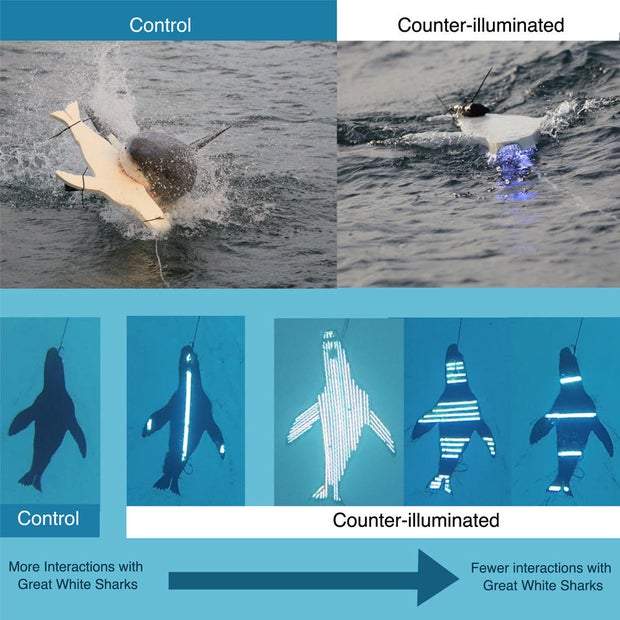
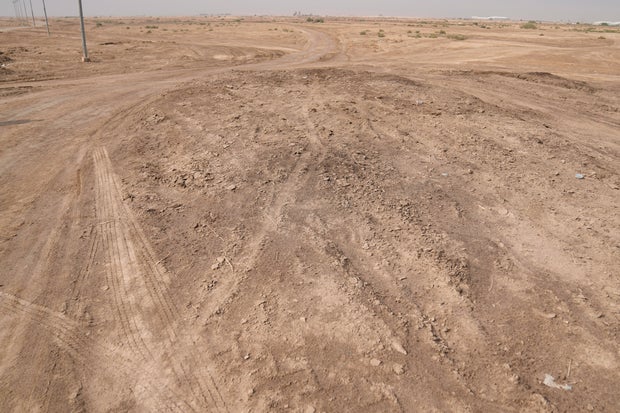
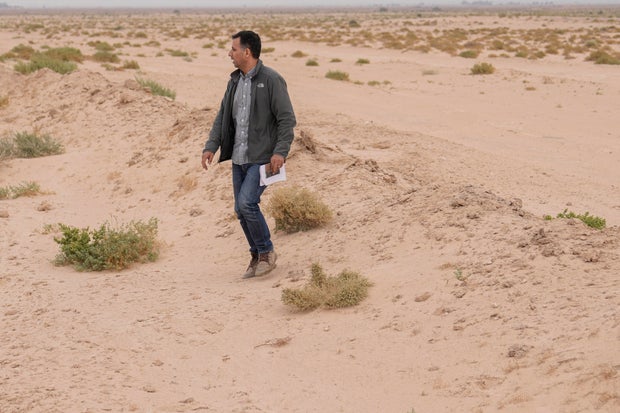
You must be logged in to post a comment Login